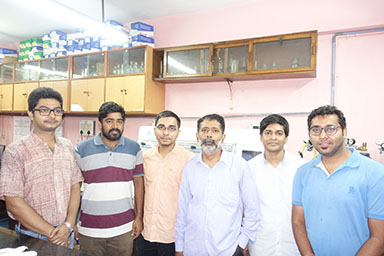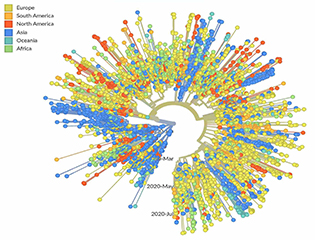
Wriddhiman Ghosh
Professor
Wriddhiman Ghosh
Professor, Biological Sciences
PhD: Bose Institute / Jadavpur University, 2006
Previous appointments:
Bose Institute Research Associate
CSIR Research Associate
Research interests:
Our Geomicrobiology Group explores the biosphere for novel molecular mechanisms/pathways of the evolutionarily ancient metabolism called sulfur-chemolithotrophy, which supposedly originated in the high-temperature reducing environments of the early Earth. Our laboratory also tries to reveal the in situ metabolisms, ecosystem opportunities/constraints, and geochemical manifestations of the microorganisms of the Carbon-Sulfur-cycle within microbiomes that have active interfaces with the Earth’s geological processes. Current focus is on the following biophysically/bioenergetically extreme habitats.
- The
geochemically peculiar (neutral pH, silica-poor, but boron-, sulfide-, sulfate-
and thiosulfate-rich) hot spring systems of the Trans-Himalayas (Eastern Ladakh,
India).
- The anoxic (sulfidic) sediments of the Arabian Sea.
Contact:
| Address: |
Biological Sciences Unified Academic Campus Bose Institute EN-80, Sector V Bidhan Nagar Kolkata - 700 091, India |
| E-Mail: | wriman[at]jcbose.ac.in |
| Phone: | +91-33-25693318 |
Research:
On the more contemporary Geomicrobiology front our researches explore the physicochemical windows of opportunity that sustain life at the entropic and bioenergetic extremities of the Earth's biosphere. We also envisage the implications that our findings hold for the biogeochemical cycles, the geobiological evolution (of the Earth), and the habitability of extraterrestrial locations.
Major findings in the last five years
· Discovery of a novel tetrathionate oxidation pathway; intersection between sulfur and methanol oxidation systems (Plate A).
· Elucidation of how geothermal communities sustain amidst erratic environmental conditions.
· Discovery of mesophiles-dominated microbiomes in Trans-Himalayan hot spring systems (Plate B)
· Elucidation of the earliest ancestors of the Green Sulfur Bacteria (Plate C).
. Our explorations revealed that the unique geochemistry of Trans-Himalayan sulfur–borax hot
springs facilitates high in situ microbial diversity, while the local geodynamics drive extensive microbial flux through the hydrothermal system.
· Discovery of hot-spots of carbon-sulfur cycling within the sediments of the Arabian Sea oxygen minimum zone (Plate D).
· Discovery of crypto-aerobic microbial life in anoxic (sulfidic) marine sediments (Plate E).
· Discovery of the cryptic role of tertathionate in the sulfur cycle of marine sediments (Plate F).
Publications:
Roy C, Mandal SM, Mondal SK, Mukherjee S, Mapder T, Ghosh W and Chakraborty R (2020) Trends of mutation accumulation across global SARS-CoV-2 genomes: Implications for the evolution of the novel coronavirus. Genomics 112: 5331-5342. https://doi.org/10.1016/j.ygeno.2020.11.003
Bhattacharya S, Roy C, Mandal S, Sarkar J, Rameez MJ, Mondal N, Mapder T, Chatterjee S, Pyne P, Alam M, Haldar PK, Roy R, Fernandes S, Peketi A, Chakraborty R, Mazumdar A and Ghosh W (2020) Aerobic microbial communities in the sediments of a marine oxygen minimum zone. FEMS Microbiology Letters 367: fnaa157. https://doi.org/10.1093/femsle/fnaa157
Mandal S, Bhattacharya S, Roy C, Rameez MJ, Sarkar J, Mapder T, Fernandes S, Peketi A, Mazumdar A and Ghosh W (2020) Cryptic roles of tetrathionate in the sulfur cycle of marine sediments: microbial drivers and indicators. Biogeosciences 17: 4611-4631. https://doi.org/10.5194/bg-17-4611-2020
Roy C, Mondal N, Peketi A, Fernandes S, Mapder T, Volvoikar SP, Haldar PK, Nandi N, Bhattacharya T, Mazumdar A, Chakraborty R and Ghosh W (2020) Geomicrobial dynamics of Trans-Himalayan sulfur–borax spring system reveals mesophilic bacteria’s resilience to high heat. Journal of Earth System Science 129: 157. DOI: https://doi.org/10.1007/s12040-020-01423-y; IAS Link: https://www.ias.ac.in/describe/article/jess/129/0157; SharedIt Link: https://rdcu.be/b5EgC
Roy C, Rameez MJ, Haldar PK, Peketi A, Mondal N, Bakshi U, Mapder T, Pyne P, Fernandes S, Bhattacharya S, Roy R, Mandal S, O’Neill WK, Mazumdar A, Mukhopadhyay SK, Mukherjee A, Chakraborty R, Hallsworth JE and Ghosh W (2020) Microbiome and ecology of a hot spring-microbialite system on the Trans-Himalayan Plateau. Scientific Reports 10: 5917. https://doi.org/10.1038/s41598-020-62797-z
Rameez MJ, Pyne P, Mandal S, Chatterjee S, Alam M, Bhattacharya S, Mondal N, Sarkar J and Ghosh W (2020) Two pathways for thiosulfate oxidation in the alphaproteobacterial chemolithotroph Paracoccus thiocyanatus SST. Microbiological Research 230: 126345. https://doi.org/10.1016/j.micres.2019.126345
Mandal S, Rameez MJ, Chatterjee S, Sarkar J, Pyne P, Bhattacharya S, Shaw R and Ghosh W (2020) Molecular mechanism of sulfur chemolithotrophy in the betaproteobacterium Pusillimonas ginsengisoli SBSA. Microbiology 166: 386-397. https://doi.org/10.1099/mic.0.000890
Sen S, Saha T, Bhattacharya S, Mondal N, Ghosh W and Chakraborty R (2020) Draft Genome Sequences of Two Boron-Tolerant, Arsenic-Resistant, Gram-Positive Bacterial Strains, Lysinibacillus sp. OL1 and Enterococcus sp. OL5, Isolated from Boron-Fortified Cauliflower-Growing Field Soils of Northern West Bengal, India. Microbiology Resource Announcements 9: e01438-19. https://doi.org/10.1128/MRA.01438-19
Roy C, Bakshi U, Rameez MJ, Mandal S, Haldar PK, Pyne P and Ghosh W (2019) Phylogenomics of an uncultivated, aerobic and thermophilic, photoheterotrophic member of Chlorobia sheds light into the evolution of the phylum Chlorobi. Computational Biology and Chemistry 80: 206-216. https://doi.org/10.1016/j.compbiolchem.2019.04.001
Saha T, Ranjan VK, Ganguli S, Thakur S, Chakraborty B, Barman P, Ghosh W and Chakraborty R (2019) Pradoshia eiseniae gen. nov., sp. nov., a spore-forming member of the family Bacillaceae capable of assimilating 3-nitropropionic acid, isolated from the anterior gut of the earthworm Eisenia fetida. International Journal of Systematic and Evolutionary Microbiology 69: 1265-73. https://doi.org/10.1099/ijsem.0.003304
Pyne P, Alam M, Rameez MJ, Mandal S, Sar A, Mondal N, Debnath U, Mathew B, Misra AK, Mandal AK and Ghosh W (2018) Homologs from sulfur oxidation (Sox) and methanol dehydrogenation (Xox) enzyme systems collaborate to give rise to a novel pathway of chemolithotrophic tetrathionate oxidation. Molecular Microbiology 109: 169-191. https://doi.org/10.1111/mmi.13972
Fernandes S, Mazumdar A, Bhattacharya S, Peketi A, Mapder T, Roy R, Carvalho MA, Roy C, Mahalakshmi P, Silva R, Rao PS, Banik SK and Ghosh W (2018) Enhanced carbon-sulfur cycling in the sediments of Arabian Sea oxygen minimum zone center. Scientific Reports 8: 8665. https://doi.org/10.1038/s41598-018-27002-2
Pyne P, Alam M and Ghosh W (2017) A novel soxO gene, encoding a glutathione disulfide reductase, is essential for tetrathionate oxidation in Advenella kashmirensis. Microbiological Research 205: 1-7. https://doi.org/10.1016/j.micres.2017.08.002
Roy C, Alam M, Mandal S, Haldar PK, Bhattacharya S, Mukherjee T, Roy R, Rameez MJ, Misra AK, Chakraborty R, Nanda AK and Ghosh W (2016) Global association between thermophilicity and vancomycin susceptibility in Bacteria. Frontiers in Microbiology 7: 412. https://doi.org/10.3389/fmicb.2016.00412
Mukherjee T, Bose S, Sen U, Roy C, Rameez MJ, Ghosh W and Mukhopadhyay SK (2016) Genome Sequence of the Red Pigment-Forming Meiothermus taiwanensis strain RP isolated from Paniphala Hot Spring, India. Genome Announcements 4: e00629-16. https://doi.org/10.1128/genomeA.00629-16
Bose S, Mukherjee T, Sen U, Roy C, Rameez MJ, Ghosh W and Mukhopadhyay SK (2016) Genome sequence of the multiple-protease-producing strain Geobacillus thermoleovorans N7, a thermophilic bacterium isolated from Paniphala Hot Spring, West Bengal, India. Genome Announcements 4: e01202-16. https://doi.org/10.1128/genomeA.01202-16
Sen U, Mukherjee T, Bose S, Roy C, Rameez MJ, Ghosh W and Mukhopadhyay SK (2016) Genome sequence of the arsenic-resistant Haladaptatus sp. strain R4 isolated from Ramnagar, West Bengal, India. Genome Announcements 4: e01017-16. https://doi.org/10.1128/genomeA.01017-16
Ghosh W, Roy C, Roy R, Nilawe P, Mukherjee A, Haldar PK, Chauhan NK, Bhattacharya S, Agarwal A, George A and Pyne P (2015) Resilience and receptivity worked in tandem to sustain a geothermal mat community amidst erratic environmental conditions. Scientific Reports 5: 12179. https://doi.org/10.1038/srep12179
Alam M and Ghosh W (2014) Optimization of a phenol extraction-based protein preparation method amenable to downstream 2DE and MALDI-MS based analysis of bacterial proteomes. Proteomics 14: 216-221. https://doi.org/10.1002/pmic.201300146
Alam M, Pyne P, Mazumdar A, Peketi A and Ghosh W (2013) Kinetic enrichment of 34S during proteobacterial thiosulfate oxidation and the conserved role of SoxB in S-S bond breaking. Applied and Environmental Microbiology 79: 4455-4464. https://doi.org/10.1128/AEM.00956-13
20. Ghosh W, Alam M, Roy C, Pyne P, George A, Chakraborty R, Majumder S, Agarwal A, Chakraborty S, Majumdar S and Gupta SK (2013) Genome implosion elicits host-confinement in Alcaligenaceae: evidence from the comparative genomics of Tetrathiobacter kashmirensis, a pathogen in the making. PLoS One 8: e64856. https://doi.org/10.1371/journal.pone.0064856
Alam M, Roy C, Pyne P, Agarwal A, George A and Ghosh W (2012) Whole-genome shotgun sequence of the sulfur-oxidizing chemoautotroph Pseudaminobacter salicylatoxidans KCT001. Journal of Bacteriology 194: 4743-4744. https://doi.org/10.1128/JB.00944-12
Ghosh W, George A, Agarwal A, Raj P, Alam M, Pyne P and Das Gupta SK (2011) Whole-genome shotgun sequencing of the sulfur-oxidizing chemoautotroph Tetrathiobacter kashmirensis. Journal of Bacteriology 193: 5553-5554. https://doi.org/10.1128/JB.05781-11
Dam B, Ghosh W and Das Gupta SK (2009) Conjugative Type 4 secretion system of a novel large plasmid from the chemoautotroph Tetrathiobacter kashmirensis and construction of shuttle vectors for Alcaligenaceae. Applied and Environmental Microbiology 75: 4362-4373. https://doi.org/10.1128/AEM.02521-08
Ghosh W, Mallick S and Das Gupta SK (2009) Origin of the Sox multienzyme complex system in ancient thermophilic bacteria and coevolution of its constituent proteins. Research in Microbiology 160: 409-420. https://doi.org/10.1016/j.resmic.2009.07.003
Ghosh W and Dam B (2009) Biochemistry and molecular biology of lithotrophic sulfur oxidation by taxonomically and ecologically diverse bacteria and archaea. FEMS Microbiology Reviews 33: 999-1043. https://doi.org/10.1111/j.1574-6976.2009.00187.x
Ghosh W and Roy P (2007) Chemolithoautotrophic oxidation of thiosulfate and tetrathionate by novel strains of Azospirillum and Pseudoxanthomonas isolated from the rhizosphere of an Indian tropical leguminous plant. Current Science 93: 1613-1615. https://doi.org/10.1111/j.1574-6968.2007.00670.x
Dam
B, Mandal S, Ghosh W, Das Gupta SK and Roy P (2007) The S4-intermediate pathway for the oxidation of thiosulfate
by the chemolithoautotroph Tetrathiobacter
kashmirensis and inhibition of tetrathionate oxidation by sulfite. Research
in Microbiology 158: 330-338.
https://doi.org/10.1016/j.resmic.2006.12.013
Ghosh W and Roy P (2007) Chemolithoautotrophic oxidation of thiosulfate, tetrathionate and thiocyanate by a novel rhizobacterium belonging to the genus Paracoccus. FEMS Microbiology Letters 270: 124-131. https://doi.org/10.1111/j.1574-6968.2007.00670.x
Ghosh W and Roy P (2006) Ubiquitous presence and activity of sulfur-oxidizing lithoautotrophic microorganisms in the rhizospheres of tropical plants. Current Science 91: 159-161. https://doi.org/10.2307/24094206
Ghosh W and Roy P (2006) Mesorhizobium thiogangeticum sp. nov., a novel sulfur-oxidizing chemolithoautotroph from rhizosphere soil of an Indian tropical leguminous plant. International Journal of Systematic and Evolutionary Microbiology 56: 91-97. https://doi.org/10.1099/ijs.0.63967-0
Ghosh W, Mandal S and Roy P (2006) Paracoccus bengalensis sp. nov., a novel sulfur-oxidizing chemolithoautotroph from the rhizospheric soil of an Indian tropical leguminous plant. Systematic and Applied Microbiology 29: 396-403. https://doi.org/10.1016/j.syapm.2005.10.004
Lahiri C, Mandal S, Ghosh W, Dam B and Roy P (2006) A novel gene cluster soxSRT is essential for the chemolithotrophic oxidation of thiosulfate and tetrathionate by Pseudaminobacter salicylatoxidans KCT001. Current Microbiology 52: 267-273. https://doi.org/10.1007/s00284-005-0176-x
Ghosh W, Bagchi A, Mandal S, Dam B and Roy P (2005) Tetrathiobacter kashmirensis gen. nov., sp. nov., a novel mesophilic, neutrophilic, tetrathionate-oxidizing, facultatively chemolithotrophic betaproteobacterium isolated from soil from a temperate orchard in Jammu and Kashmir, India. International Journal of Systematic and Evolutionary Microbiology 55: 1779-1787. https://doi.org/10.1099/ijs.0.63595-0
View MoreRecognition:
Teaching:
For the Integrated MSc-PhD program in Life Sciences
Course 408: Microbiology (T1:P1:L15)
Course 502: Genetics and Genomics (T2:P1.5:L30)
For the PhD course work program in Life Sciences
Course B24: Genetics and Proteomics
Students:
| Image | Name | Designation | Department | Campus | Contact number | |
|---|---|---|---|---|---|---|
 |
Jit Ghosh | Junior Research Fellow | Bioinformatics Centre | Unified | gjit226@gmail.com | |
 |
Mahamadul Mondal | Junior Research Fellow | Microbiology | Centenary | mahamadulmondal@gmail.com | |
 |
Subhajit Dutta | Junior Research Fellow | Microbiology | Centenary | subhajitduta3794@gmail.com | |
 |
Sumit Chatterjee | Junior Research Fellow | Microbiology | Centenary | schatterjee@jcbose.ac.in |
Former:
Former Group Members:
Dr.
Masrure Alam (Doctoral Fellow and Research Associate)
Dr. Prosenjit Pyne (Doctoral Fellow)
Dr. Chayan Roy (Doctoral Fellow)
Dr. Moidu Jameela Rameez (Doctoral Fellow)
Mr. Subhrangshu Mandal (Doctoral Fellow, submitted PhD thesis in Feb 2020)
Mr. Sabyasachi Bhattacharya (Doctoral Fellow, about to submit PhD thesis)
Current Group Members:
Mr. Nibendu Mondal (Senior Research Fellow)
Mr. Jagannath Sarkar (Junior Research Fellow)
Mr. Sumit Chatterjee (Junior Research Fellow)

Group News:
We the geomicrobiologists re-purposed our genomics expertise for the cause of the millennium: comprehensively elucidated global mutation trends, and their evolutionary implications, in SARS-CoV-2; the findings (published in Genomics Volume 112, Issue 6, 2020, pages 5331-5342; https://doi.org/10.1016/j.ygeno.2020.11.003) hold critical clues for drug and vaccine development against COVID-19.

In January 2020, we carried out a comprehensive field expedition in collaboration with Dr. Sanat Kumar Das (Environmental Science Section, Bose Institute) to explore air-/aerosol-borne microbiome along a "Himalayas (Darjeeling) to Coastal Bay of Bengal (Sundarban)" transect. Microbial community analysis for the samples retrieved is going on in full swing alongside analysis of the atmospheric science data by Dr. S. K. Das.


